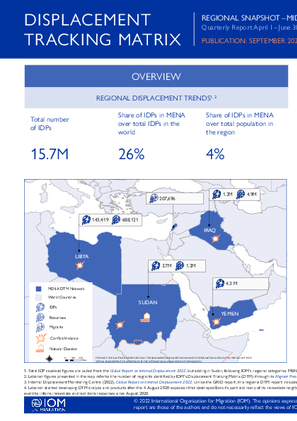-
Countries
-
Data and Analysis
-
Special Focus
-
Crisis Responses
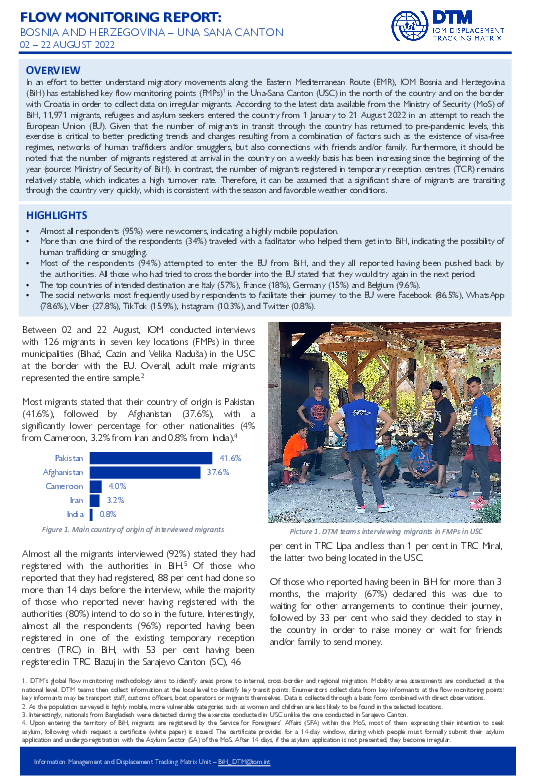
Contact
DTM Europe, DTMMediterranean@iom.int
Language
English
Location
Bosnia & Herzegovina
Snapshot Date
Aug 31 2022
Activity
- Flow Monitoring
- Migrants presence
- Mobility Tracking
In an effort to better understand migratory movements along the Eastern Mediterranean Route (EMR), IOM Bosnia and Herzegovina (BiH) has established key flow monitoring points (FMPs) 1 in the Una-Sana Canton (USC) in the north of the country and on the border with Croatia in order to collect data on irregular migrants. According to the latest data available from the Ministry of Security (MoS) of BiH, 11,971 migrants, refugees and asylum seekers entered the country from 1 January to 21 August 2022 in an attempt to reach the European Union (EU).
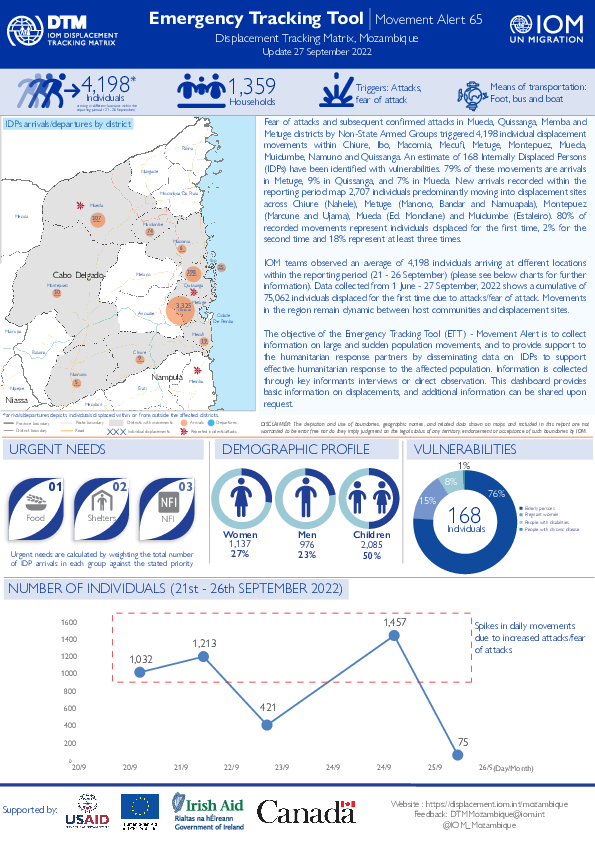
Contact
DTMMozambique@iom.int
Language
English
Location
Mozambique
Period Covered
Sep 21 2022
Sep 26 2022
Activity
- Mobility Tracking
- Event Tracking
Fear of attacks and subsequent confirmed attacks in Mueda, Quissanga, Memba and Metuge districts by Non-State Armed Groups triggered 4,198 individual displacement movements within Chiure, Ibo, Macomia, Mecufi, Metuge, Montepuez, Mueda, Muidumbe, Namuno and Quissanga. An estimate of 168 Internally Displaced Persons (IDPs) have been identified with vulnerabilities. 79% of these movements are arrivals in Metuge, 9% in Quissanga, and 7% in Mueda. New arrivals recorded within the reporting period map 2,707 individuals predominantly moving into displacement sites across Chiure (Nahele), Metuge (Manono, Bandar and Namuapala), Montepuez (Marcune and Ujama), Mueda (Ed. Mondlane) and Muidumbe (Estaleiro). 80% of recorded movements represent individuals displaced for the first time, 2% for the second time and 18% represent at least three times. IOM teams observed an average of 4,198 individuals arriving at different locations within the reporting period (21 - 26 September) (please see below charts for further information).
Data collected from 1 June - 27 September, 2022 shows a cumulative of 75,062 individuals displaced for the first time due to attacks/fear of attack. Movements in the region remain dynamic between host communities and displacement sites. The objective of the Emergency Tracking Tool (ETT) - Movement Alert is to collect information on large and sudden population movements, and to provide support to the humanitarian response partners by disseminating data on IDPs to support effective humanitarian response to the affected population. Information is collected through key informants interviews or direct observation. This dashboard provides basic information on displacements, and additional information can be shared upon request.

Contact
DTMMediterrean@iom.int
Language
English
Location
Romania
Period Covered
May 04 2022
Sep 12 2022
Activity
- Survey
Starting on 24 February 2022, the war in Ukraine triggered an unprecedented humanitarian crisis and generated large scale displacement both within Ukraine and to the neighbouring countries. As of 9 September 2022, almost 7 million persons were internally displaced in Ukraine1 and over 12.5 million crossings of refugees and other Third-Country-Nationals (TCNs) not in need of international protection from Ukraine into the neighbouring countries were reported.2 However, an increasing number crossings back into Ukraine, with UNHCR reporting over 5.7 million crossings from neighbouring countries into Ukraine as of 13 September 2022.
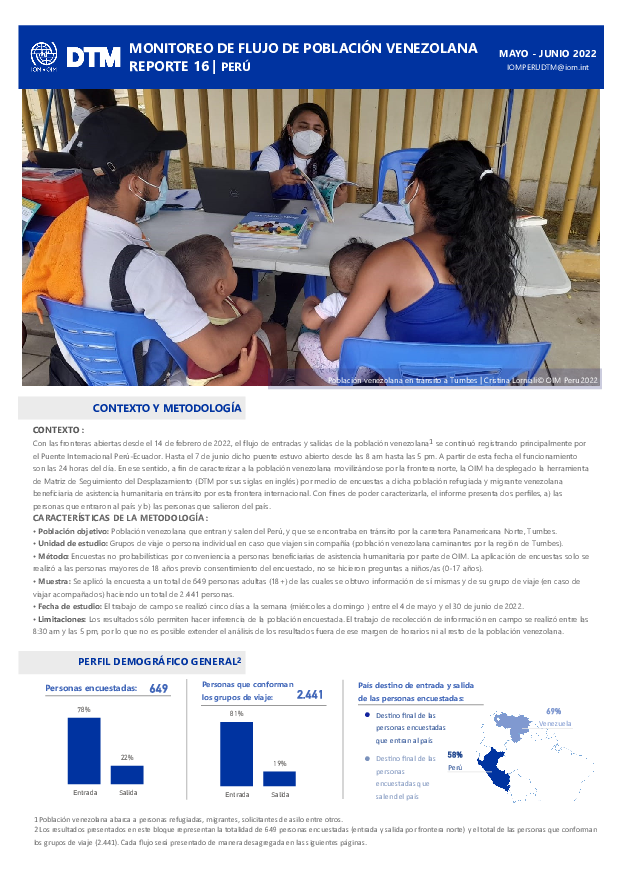
Contact
DTM Peru, IOMDTMPeru@iom.int
Language
English
Location
Peru
Period Covered
May 04 2022
Jun 30 2022
Activity
- Flow Monitoring
Con las fronteras abiertas desde el 14 de febrero de 2022, el flujo de entradas y salidas de la población venezolana se continuó registrando principalmente por el Puente Internacional Perú-Ecuador. Hasta el 7 de junio dicho puente estuvo abierto desde las 8 am hasta las 5 pm. A partir de esta fecha el funcionamiento son las 24 horas del día. En ese sentido, a fin de caracterizar a la población venezolana movilizándose por la frontera norte, la OIM ha desplegado la herramienta de Matriz de Seguimiento del Desplazamiento (DTM por sus siglas en inglés) por medio de encuestas a dicha población refugiada y migrante venezolana beneficiaria de asistencia humanitaria en tránsito por esta frontera internacional. Con fines de poder caracterizarla, el informe presenta dos perfiles, a) las personas que entraron al país y b) las personas que salieron del país.
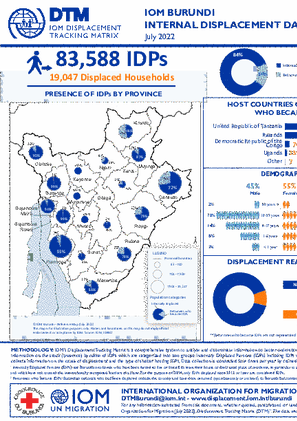
Contact
DTM Burundi, DTMBurundi@iom.int
Language
English
Location
Burundi
Snapshot Date
Jul 31 2022
Activity
- Mobility Tracking
- Baseline Assessment
DTM has identified 83,588 internally displaced persons (IDPs) in 19,047 households, 91% of the displacement were due to natural disasters and 9% other reasons.

Contact
DTM Burundi, DTMBurundi@iom.int
Language
French
Location
Burundi
Snapshot Date
Jul 31 2022
Activity
- Mobility Tracking
- Baseline Assessment
La DTM a identifié 83 588 personnes déplacées internes (PDI) réparties dans 19 047 ménages déplacés, 91% des déplacements étaient dus à des désastres nasturels et 9% à d'autre raisons.
The Displacement Tracking Matrix (DTM) provides primary data and information on internal displacement and population movements – incountry and at regional and global levels. DTM’s work worldwide informs humanitarian, recovery, transition and development interventions by providing timely data and analysis to relevant actors including governments, United Nations partner agencies, donors and other stakeholders. DTM operates in contexts where conflict, natural disasters and complex emergency settings can cause short-term or protracted displacement, as well as in mixed migration contexts. In the Middle East and North Africa (MENA) region, there were 15.7 million internally displaced persons (IDPs) in 2021. This figure constitutes 26 per cent of the global population of IDPs, making MENA the region with the second highest concentration of IDPs worldwide (following the sub-Saharan Africa region). Most displacement in the MENA region (81%) has been triggered by armed conflict, in particular in Iraq, Libya, Syria and Yemen.

Contact
DTM Sudan; dtmsudan@iom.int
Language
English
Location
Sudan
Snapshot Date
Sep 29 2022
Activity
- Mobility Tracking
- Event Tracking
The Rainy Season in Sudan typically occurs on an annual basis with greatest concentration between the months of June and September. In 2021, all flooding EETs were implemented between the month of July and September. In 2022, DTM Sudan first implemented its EET to monitor flooding taking place in At Tadamon locality, South Kordofan in May. The need for the implementation of a flooding EET this early in the year reflects the fluctuating raining patterns across Sudan, particularly across the water basins of the two Nile rivers.
The information provided reflects published data collected by DTM Sudan’s Emergency Event Tracking tool up to 29 September 2022. Data collection exercises covering the Rainy Season remain ongoing with the rates of displacement data expected to decrease gradually as the rainy season is beyond its peak. Many localities still remain inaccessible to the humanitarian community due to the extreme weather patterns.

Contact
DTM South Sudan, SouthSudanDTM@iom.int
Language
English
Location
South Sudan
Period Covered
Jan 01 2022
Mar 31 2022
Activity
- Flow Monitoring
IOM’s Displacement Tracking Matrix (DTM) continued conducting Displacement Site Flow Monitoring (DSFM) at the gates of Naivasha IDP camp. During this period, 2,924 interviews were conducted representing 12,275 individual movements into / out of the camp. Surveyed day movements were predominantly undertaken by female travelers (76%) and saw an increase of 3 per cent in the first quarter of 2022. The main reasons for movement were tending to other livelihood activities (51%) and visiting friends / family (26%). Individuals who engaged in temporary movements increased from 14 to 34 individuals during this quarter and did so to mainly visit friends or family (44%) and attempt to return home (39%), with women and girls dominating these movements. Thirty-two per cent of travelers intend to spend at least one to seven days in their locations of destination. New arrivals saw an increase of 15 individuals. The majority moved into the camp due to hunger (44%) & insecurity caused by conflict (38%) in their departure locations. Forty-four per cent of the new arrivals intend to spend more than 6 months in the camp. Individuals who permanently exited the camp reduced by 48 per cent and were dominated by female travelers (62%). Most of those individuals permanently exiting the camp are headed to their former homes (45%) in Wau county.
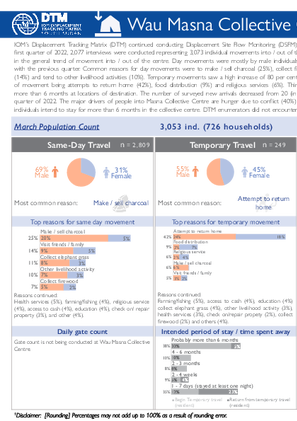
Contact
DTM South Sudan, SouthSudanDTM@iom.int
Language
English
Location
South Sudan
Period Covered
Jan 01 2022
Mar 31 2022
Activity
- Flow Monitoring
IOM’s Displacement Tracking Matrix (DTM) continued conducting Displacement Site Flow Monitoring (DSFM) at the gates of Wau Masna Collective Centre. In the first quarter of 2022, 2,077 interviews were conducted representing 3,073 individual movements into / out of the collective centre. This reflects a 5 per cent decrease in the general trend of movement into / out of the centre. Day movements were mostly by male individuals (69%) and decreased by 11 per cent in comparison with the previous quarter. Common reasons for day movements were to make / sell charcoal (25%), collect firewood or elephant grass (18%), visit friends or family (14%) and tend to other livelihood activities (10%). Temporary movements saw a high increase of 80 per cent compared to the previous quarter, with main reasons of movement being attempts to return home (42%), food distribution (9%) and religious services (6%). Thirty-eight per cent of these individuals intend to spend more than 6 months at locations of destination. The number of surveyed new arrivals decreased from 20 (in the last quarter of 2021) to 15 individuals in the first quarter of 2022. The major drivers of people into Masna Collective Centre are hunger due to conflict (40%) and access to general healthcare services (34%). Most individuals intend to stay for more than 6 months in the collective centre. DTM enumerators did not encounter individuals who intend to permanently exit the centre.
